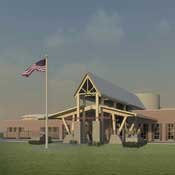Cities and counties around Mississippi are "going green" with earth-friendly schools. The buildings may not have futuristic solar panels or space-age architecture, but they do have technology that can save money and the environment.
The new Hancock County North Central Elementary School in Kiln is set to be the first LEED-certified K-12 school in the state. LEED, or Leadership in Energy and Environmental Design, is a certification system that rates buildings based on location, use of building resources, energy efficiency and other criteria.
Sally Zahner is the Green Schools Committee leader for the Mississippi chapter of the U.S. Green Building Council, which manages LEED. She is also an architect with Eley Guild Hardy Architects, which designed the school. Zahner said the LEED for Schools program focuses largely on energy efficiency and air quality to provide a healthy learning environment. LEED schools have filtered air, plenty of daylight and paint without harmful fumes.
"There's nothing harmful in the air when kids start school," she said.
Much of what makes a school LEED certified goes on behind the scenes. LEED schools have good acoustic quality with fewer distracting noises so children can hear their teachers better, Zahner said, and they are energy efficient to cut maintenance costs.
"Most of it won't really be evident when you walk on campus," she said.
USGBC offers four levels of certification--certified, silver, gold and platinum-- which are awarded based on how sustainable, efficient and innovative the building is.
Jon McCraw, business officer for the Hancock County School District, said demolition started last week to make way for the new elementary school. He expects the building to take a little bit more than a year to complete, and current plans call for it to be LEED certified silver.
Although there are some additional costs to register and certify a building with USGBC, Zahner said the fees are minimal compared to the overall cost of the building, and she was able to work with the school to stay within their budget.
Registering a proposed project intended to be LEED certified costs $450 to 600, according to the USGBC. After the building's completion, certification costs an average of $2,000.
Jeff Seabold, chair of the board of the Mississippi chapter of USGBC and the owner of Seabold Architectural Studio, said LEED schools can save almost $100,000 per year in direct and indirect costs. He added that better air quality and safer building materials in schools can reduce instances of asthma and headaches, while more daylight helps students perform better.
The Rankin County School District completed its administration building in 2009, which was then LEED certified silver. Gary LaRose, project manager for RCSD, said building a LEED school added less than 2 percent to the total construction cost of about $6 million. In about seven years, however, LaRose expects the school to make up for the added costs in energy savings. He said the building saves about $18,000-20,000 per year on energy.
"We've got an environmentally friendly building that is much safer and more comfortable for the children, and also saves on energy," he said.
Several universities in the state are constructing green buildings. The new Oxford High School, currently in the design phase, is also aiming for LEED certification.
Jackson Public Schools registered its intention to make Bates Elementary- Cardozo Middle School a LEED building in 2007, but did not follow through on certification. Fred Davis, executive director of facilities and operations for JPS, said getting the building LEED certified at the highest level was cost prohibitive, but they incorporated many green initiatives into the design. Davis said JPS is still looking into getting schools certified in the future, but for now they are incorporating many of the LEED standards and principles into new buildings and renovations.
The green initiatives JPS is using include automatic hand dryers, high-efficiency heating and cooling systems, paints with mold inhibitors and low-maintenance flooring that requires fewer chemicals to clean.
Some states, such as Montana and Rhode Island, still do not have any LEED schools, although some, such as Pennsylvania, Florida and California, have dozens.



Comments
Use the comment form below to begin a discussion about this content.